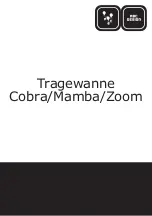
Page 4 of 8
CONTENTS
1
G
ENERAL DESCRIPTION
4
2
A
PPLICATIONS
4
3
O
PERATING CONDITIONS
4
4
C
ONTROLLER LOCATION
4
5
E
LECTRICAL CONNECTION
4
6
O
PERATION
5
7
M
AINTENANCE
5
8
D
ISPOSAL
5
Before beginning installation procedures, these
Installation and operating instructions should be studied
carefully. The installation and operation should also be in
accordance with local regulations and accepted codes of
good practice.
1.
General descr iption
This transformer speed-controller is designed to be used in
combination with an electric motor which is suitable for speed
control by means of a transformer. The controller can control the
speed of the motor in 5 steps (level 1 - 2 - 3 - 4 - 5, both at 1- and
3-phase). Several ventilators (also with motors of different ratings)
may be connected to one controller. However the total load current
must not exceed the nominal output current of the controller.
1.1
Applications
q
Motor(s) for connection to the controller must be suitable for
transformer reduced voltage speed control.
q
The total maximum current load of (all) the motor(s) connected
to the controller must not exceed the nominal output current of
the controller.
2.
Operating conditions
The maximum admissible ambient temperature during operation is
+40 °C. When the controller is not in operation, the maximum
admissible ambient temperature is –20°C to +60°C.
3.
Controller location
q
The controller must be mounted vertically onto a solid surface,
alternatively it may be mounted to a solid horizontal surface .
q
The controller must not be mounted upside down. The cable
entries should point down.
q
The controller must not be mounted directly under, or onto the
ceiling To ensure adequate cooling, a minimum distance ol 5
cm is required around the controller.
4.
Installation
1.
Remove the cover of the controller
2.
Mounting holes are provided on the inside back panel of the
enclosure.
3.
On some of the plastic enclosures, the mounting holes should
be opened by knocking out the membrane covering the
mounting hole.
4.
For the ease of mounting, the mounting plate (inside) may be
removed from the enclosure. The controller enclosure should
be mounted using corrosion resistant screws or bolts as
required. Once secured in position, the mounting screws or
bolts should be sealed to maintain the IP-rating of the
enclosure, i e IP 54.
5.
Electrical connection
All electrical connections should be carried out by qualified and
authorized electrician in accordance with national and local
regulations.
Before connecting the controller, please ensure that the
electrical supply has been suitably isolated and cannot
be switched on!
The nominal voltage of the controller must be suitable for the
electrical supply to which it will be connected.
The controller should be wired in accordance with the wiring
diagram supplied with the controller and markings on the terminals.
The earth-wire (green-yellow) of the electrical supply
and of any equipment connected to the controller must
be connected to the terminals marked PE.
Once all wiring to the controller has been completed, check that
connections have been made to the correct terminals and that all
connections are secure.
Finally replace the cover and ensure the securing screws are tight to
prevent ingress of dirt and moisture.
VRDE, VRDT:
Additional connections (marked 1,2,3) for e.g. contacts of an
external clock for switching between the 2 selected speeds /
setpoints of the two speed-selection-switches.
VRDT, VRTT:
Additional connections for the thermal contacts from the motors
(marked TK20 and TK21), and connections for e.g. two thermostats
(marked RT-RT and FS- FS).
Terminals marked (SL,N) for external failure signal.
VRTE:
Connections for valve- or servomotor:
A valve- (close-off flap) or servomotor may be connected to
terminals NK and LK (marked "KLAPPE').
A 230 V (max load 40 V A) supply is available at these terminals,
when the controller is switched on. If connection to external
devices is not used, terminals NK and LK must not be linked
together!
Note:
The voltage at the terminal “LK “ will be disconnected, If the
control switch is in the "O'-position, or if the motor thermal switch
contacts (at terminals "TK") open.
6.
Operation
1.
Check if the switch(es) of the controller is (are) in “0" position.
2.
Check the mains supply voltage (nominal voltage.tolerance
+6%/-10%).
3.
Switch on the mains power supply first and then the controller
The green light on the outside of the enclosure will be on.
4.
Check the voltage given in every switch position.
5.
In case of failure check the fuse (inside of the enclosure, or
external).
7.
Maintenance
The controller needs no specific maintenance. The housing may be
cleaned using a moist cloth It must not be hosed down.
8.
Disposal
Disposal of this product or parts of it must be carried out according
to the following guidelines
1.
Use the local public or private waste collection service
2.
In case such waste collection service does not exist or cannot
handle the materials used In the product please deliver the
product or any hazardous materials from it to your nearest
Östberg company or service workshop
S
UBJECT TO ALTERATIONS
GB


























